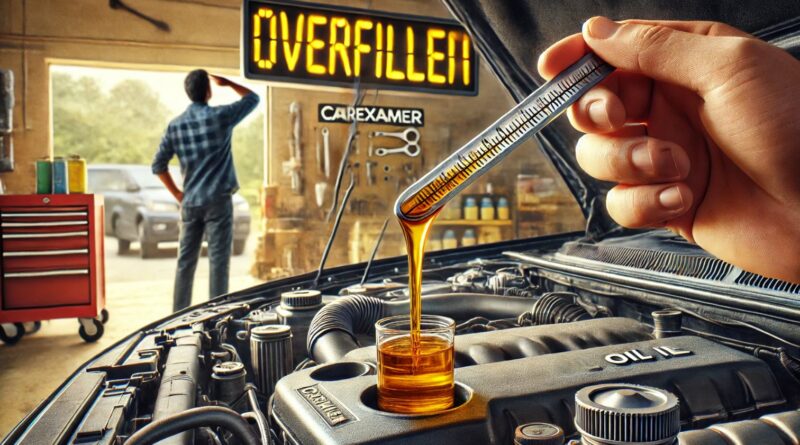Is It OK if the Engine Oil Level Is Above the Maximum?
Here’s a breakdown if engine oil level Is above the maximum, what risks come with it, and how to fix it if it happens. We’ve all been there—checking the dipstick only to realize the engine oil level is a bit (or more than a bit) above the maximum line. So, is it safe to drive? While it may seem harmless, too much oil can actually be hard on your engine.
1. Why the Right Oil Level Matters
Engine oil does more than just keep things running smoothly—it’s essential for lubricating moving parts, reducing friction, and cooling the engine. Ideally, your oil should be within the minimum and maximum marks on the dipstick. When it’s below the minimum, you risk engine wear from lack of lubrication. But if it’s above the maximum, it can bring its own set of problems.
2. What Happens When There’s Too Much Oil?
While a little extra oil may seem like no big deal, an overfilled engine can lead to several issues. Here’s why you’ll want to keep that level in check:
a. Oil Foaming
With too much oil, moving parts in the engine can come into contact with it, causing it to foam up. Foamy oil doesn’t lubricate well, which means your engine isn’t getting the smooth coating it needs, leading to more wear and tear.
b. Increased Pressure on Seals and Gaskets
When there’s too much oil, pressure builds up in the crankcase (the area that houses the crankshaft), which can strain seals and gaskets. This can lead to leaks or even blow out a seal, which is a costly repair.
c. Risk of Engine Sludge
Extra oil can collect on parts, creating a thick sludge that can clog vital pathways. Over time, this sludge can damage essential components like pistons, the camshaft, and the crankshaft, potentially leading to pricey repairs.
d. Damage to the Catalytic Converter
If oil seeps into the combustion chamber, it can burn off and release fumes that harm the catalytic converter. Replacing a catalytic converter isn’t cheap, so avoiding excess oil can help keep it in good shape.
3. Is It Safe to Drive with Too Much Oil?
In short, it’s best to avoid driving with overfilled oil. If you absolutely have to, keep it short and slow to reduce the chance of causing foamy oil or building up too much pressure. But driving regularly with excess oil puts you at risk of damaging vital parts, which could mean higher repair costs down the road.
4. What to Do If You’ve Overfilled the Oil
If you’ve checked the dipstick and see that the oil level is above the maximum, here’s how you can handle it:
a. Drain Some Oil
If you’re handy with a wrench, you can remove the oil drain plug and let a little oil out. Be careful to go slowly and check the dipstick regularly so you don’t take out too much. If you’re unsure about doing this yourself, a mechanic can help.
b. Use an Oil Extractor Pump
An oil extractor pump is a quick, easy way to remove excess oil without a mess. Just place the pump’s hose into the dipstick tube and pump out small amounts until the level is back to normal.
c. Take It to a Mechanic
If you’re not comfortable removing the oil yourself, a mechanic can do it for you. They can also check for any damage if you’ve already driven with too much oil.
5. How to Avoid Overfilling Next Time
To prevent overfilling, make a habit of adding oil gradually and checking often. Here are a few tips to get it right:
- Add oil in small amounts and check the dipstick frequently.
- Use a funnel to avoid spills, which can lead to accidental overfilling.
- Double-check after adding oil to ensure you’ve reached the perfect level.
6. What If the Overfill Is Minor?
If the oil is just a millimeter or two above the maximum, it’s likely safe to drive short distances, but it’s still best to drain a little if possible. Even a small overfill can lead to increased pressure over time, so it’s worth adjusting the level as soon as you can.
7. FAQs About Overfilled Oil
Is it OK to overfill oil by a small amount?
Yes, a slight overfill isn’t likely to cause immediate issues, but draining any excess as soon as possible is still a good idea to avoid long-term effects.
Can too much oil cause the check engine light to come on?
Yes, excess oil can sometimes trigger the check engine light. If it’s on and your oil is overfilled, draining the excess could solve the problem.
What are the signs of too much oil in the engine?
If you notice leaks, bluish exhaust smoke, or reduced performance, these could all be signs of excess oil.
Final Thoughts
Keeping your engine oil at the right level is essential for protecting your car and avoiding unnecessary repairs. If you find you’ve overfilled it, don’t worry—it’s an easy fix. Just drain a little, check often, and next time, add slowly to prevent an overfill. By keeping your oil levels just right, you’re helping your engine stay in top shape for the long haul.
Buying a used VW. Buying used vauxhall, BMW, Jaguar, Ford, Volvo, Range rover, Bentley, Aston Martin, Porsche, Ferrari, Lamborghini, Maserati, Hyundai, Tesla, Honda, Pagani

